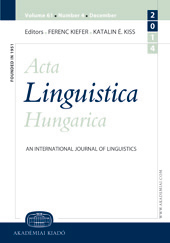Emotional Activation Measured Using the Emotional Stroop Task in Early Hungarian–Serbian Bilinguals From Serbia
Emotional Activation Measured Using the Emotional Stroop Task in Early Hungarian–Serbian Bilinguals From Serbia
Author(s): Beáta Grabovac, Csaba PléhSubject(s): Language studies, Geography, Regional studies, Applied Linguistics, Finno-Ugrian studies, South Slavic Languages, Philology
Published by: Akadémiai Kiadó
Keywords: emotional Stroop task; negative words; positive words; neutral words; bilingualism; Hungarian; Serbian;
Summary/Abstract: The primary goal of this research was to examine the processing of emotionally valenced and neutral words in the context of bilingualism. The objective was to find out, using an experimental measure of automatic emotional activation, if there were differences in response time in the first and the second language, Hungarian and Serbian respectively. The sample consisted of early Hungarian–Serbian bilinguals, assimilated into the Serbian majority culture. The emotional Stroop task is an experimental paradigm, which has been adapted to measurebilingual population in the past few years. The emotional Stroop interference could be counted from response time latencies, which is usually an effect showing longer responses to negative vs. neutral information. Hungarian and Serbian negatively, positively and neutrally valenced words were used in the research. Our hypothesis was that there would be a similar emotional activation in the first and the second language and that negative words would be processed the longest. The result of the research was a significant main effect of word type, where the negative information captured the attention for a longer period of time than the neutral one. A similar pattern of word processing showed in both languages, there were no significant differences between Hungarian and Serbian reaction times and the interaction between word type and language was not significant. The results suggested that early Hungarian–Serbian bilinguals were equally effective and fast in monitoring emotional information in both of their languages, giving emphasis through more elaborative processing to the threatening stimuli.
Journal: Acta Linguistica Hungarica (Since 2017 Acta Linguistica Academica)
- Issue Year: 61/2014
- Issue No: 4
- Page Range: 423-441
- Page Count: 19
- Language: English

